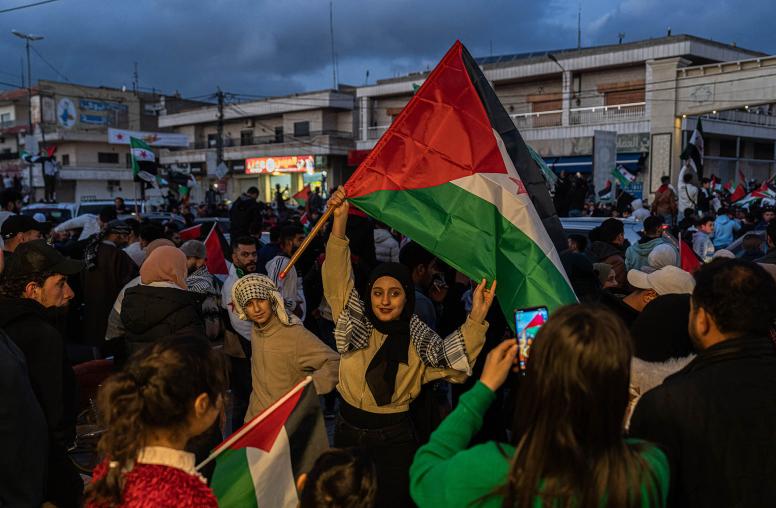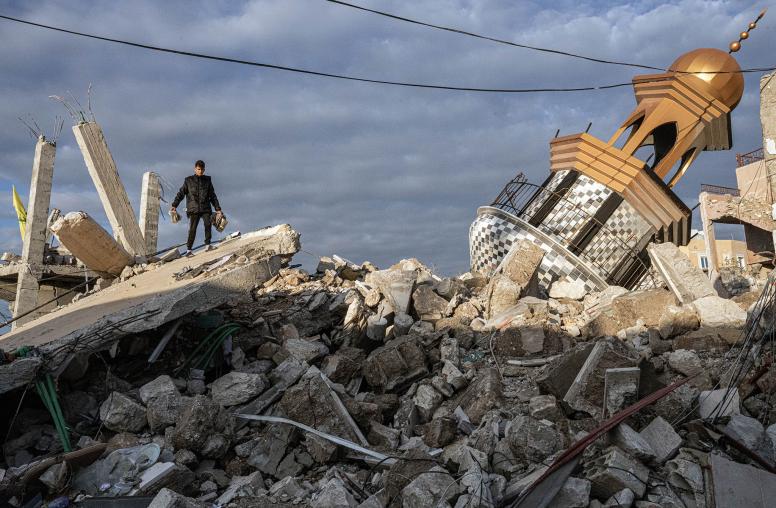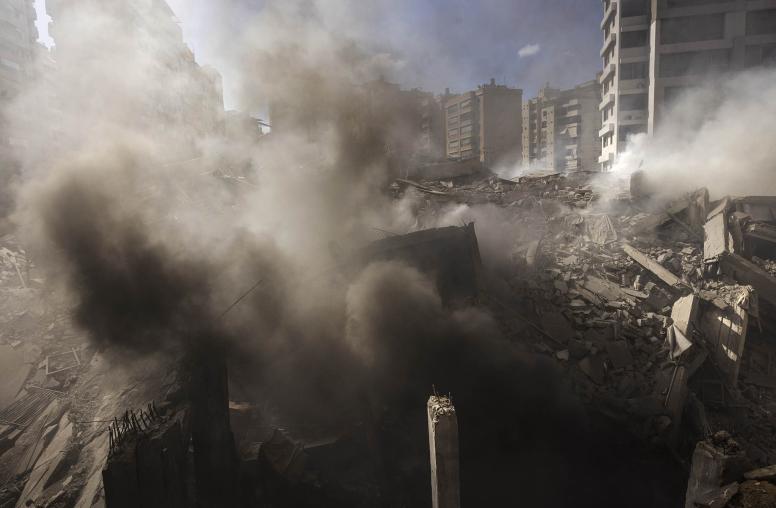What’s Next for Lebanon? Examining the Implications of Current Protests
Testimony before the House Foreign Affairs Subcommittee on Middle East, North Africa, and International Terrorism
Mona Yacoubian, senior advisor to the vice president of Middle East & Africa, testified on November 19 at the House Foreign Affairs Subcommittee on Middle East, North Africa, and International Terrorism's hearing on “What’s Next for Lebanon? Examining the Implications of Current Protests.” Her expert testimony as prepared is presented below.
Introduction
Chairman Deutch, Ranking Member Wilson and members of the House Foreign Affairs Subcommittee on Middle East, North Africa, and International Terrorism, thank you for the opportunity to testify on the implications of the current protests in Lebanon. The timing for this hearing is especially important given the dramatic nature of the protests in Lebanon and the challenges and potential opportunities they pose to U.S. interests.
I am a senior advisor on Syria, Middle East and North Africa at the United States Institute of Peace, although the views expressed here are my own. The U.S. Institute of Peace was established by Congress over 35 years ago as an independent, nonpartisan national institute to prevent and resolve violent conflicts abroad, in accordance with U.S. national interests and values.
Overview
Since October 17, Lebanon has witnessed historic mass protests, bringing more than one million people to the streets across their country. Sparked by a government decision to tax the use of the popular messaging service, What’sApp, the demonstrations quickly morphed into a broad-based popular revolt against Lebanon’s corrupt, sectarian system of government. The tax was immediately rescinded, but Lebanese popular frustrations over decades of a sectarian system marked by pervasive corruption, poor governance, and inadequate services were unleashed. Under pressure from the protests, Prime Minister Saad Hariri resigned on October 29. The protestors are demanding an independent, technocratic cabinet, a reform plan, improved services, a new electoral law and early elections. Many are calling the protests nothing less than a revolution.
Looming Economic Catastrophe
The largely peaceful uprising comes amidst a mounting financial crisis in Lebanon that could bring about a total collapse of the economy. While Lebanon observers have long marveled at the country’s fabled resilience, it appears that Lebanon has reached a moment of reckoning. The economy’s warning lights have been blinking red for some time: the IMF noted near zero growth (0.3%) for 2018, with continued weak growth projected for 2019. A stagnant economy has prompted mounting unemployment, especially among youth. Lebanon’s debt to GDP ratio is among the highest in the world; its fiscal deficit is ballooning, burdened by high debt service, a bloated public sector, and longstanding electricity subsidies. Plummeting investor confidence has led to a steep decline in net capital inflows. Taken together, these dynamics have resulted in a severe foreign exchange shortage. Limits on bank withdrawals and concerns over fuel, and even food shortages, have contributed to a growing sense of panic. In short, Lebanon is on the verge of a catastrophic economic meltdown.
The latest protests in Lebanon are not a new phenomenon. The 2005 Cedar Revolution prompted an end to the Syrian occupation of Lebanon following the assassination of former Prime Minister Rafiq Hariri. More recently, the You Stink campaign in 2015 reflected popular disgust with mountains of uncollected garbage, a potent reminder of the Lebanese government’s poor performance and its inability to deliver the most basic of public services. As with the 2019 demonstrations, both past instances were characterized by large, peaceful protests demanding change.
Positive Precedents Set
But the current protests are different from these past efforts in important, precedent-setting ways. Taken together, these dynamics imbue the movement with a sense of hope, even with the looming peril surrounding it:
- Anti-sectarian. Encompassing all sects (i.e. cross-sectarian), the protests are decidedly anti-sectarian. Previously, protest movements have been captured by sectarian interests, leading to their demise or provoking greater polarization. Thus far, demonstrators have resolutely rejected efforts to inject sectarian demands or rhetoric into the protests. Quite the opposite. The Lebanese flag and anthem—key symbols of national identity—are hallmarks of the current demonstrations. Protestors have strived to reach out across the sectarian divide, pledging unity as Lebanese and demanding an end to Lebanon’s sectarian system. In one notable example, demonstrators in Tripoli—by many accounts the “cradle of the revolution”—a Sunni dominant city, chanted in support of their counterparts in Tyre and Nabatieh, Shia strongholds dominated by Hezbollah and Amal.
- Geographically diverse. Marches and demonstrations continue to occur across Lebanon, from the north to the south, from the Bekaa valley to the coast. They have encompassed large cities and smaller towns. Organizers have coordinated their efforts across the country in a variety of ways. On one day, demonstrators formed a human chain along the length of the country, literally embodying the geographic expanse of the movement.
- Women and youth at the forefront. Women are playing an outsize role in the protests. They are often front and center, leading marches and sit-ins. In some instances, women have formed circles around male demonstrators to protect them from arrest. Students are also prominent in the protests, organizing teach-ins with professors and infusing the movement with dynamism and energy.
- Civic engagement. Themes of civic engagement resonate across the protests. Discussion circles and debates on a broad range of issues occur daily across the country. Doctors and lawyers are volunteering their services to those in need. A pop-up soup kitchen has been set up in downtown Beirut. Independent and social media outlets serve as a check on mainstream media, ensuring more open expression. Online activists have created a “guide to the revolution.”
Where is Lebanon heading?
The early optimism of the protests has given way to fears about darker scenarios unfolding. Two looming, dangerous dynamics—if unchecked—can quickly engulf Lebanon in widespread chaos and violence:
- Impending financial collapse: Despite the urgency of Lebanon’s financial crisis, the government has yet to take significant action. Conditions continue to deteriorate with no sign that the caretaker government is undertaking any of the necessary measures to begin to restore confidence and stave off a financial collapse. The failure to address increasingly acute debt and liquidity issues is heightening concerns regarding a default on the debt, insolvency of the banking system and a significant devaluation of the Lebanese pound. Even in the best case, the middle and lower classes will suffer from the consequences of painful economic adjustment. In the worst case, Lebanon will experience an economic meltdown which will quickly translate into a security nightmare.
- Protests turn violent: To date, the demonstrations have remained remarkably peaceful despite efforts by darker elements to agitate and turn the protests violent. For the most part, Lebanese security forces have acted with restraint. They have allowed the protestors to organize, march, and demonstrate unfettered. However, on November 12, the demonstrations’ first fatality came after a soldier fatally shot a protestor at a roadblock. The soldier was detained, and the army immediately opened an investigation into the incident. Amidst high tensions, the incident is a stark reminder of how quickly the demonstrations can devolve to violence.
More insidious and concerning is the appearance of thugs armed with knives or guns at some protests. These incidents are increasingly reported in south Lebanon where gunmen affiliated with Amal reportedly threatened peaceful demonstrators near Tyre. Hezbollah supporters are also reported to have threatened protestors in the south. Other reports suggest elements connected to Lebanese President Michel Aoun and his Free Patriotic Movement have brandished weapons and even fired on demonstrators. Any of these incidents could spark more significant violence. Lebanon’s past is replete with examples of minor skirmishes quickly escalating into widespread unrest.
Implications for U.S. Policy
Lebanon’s revolutionary moment holds important implications for U.S. national security interests which are predicated on maintaining security and stability in the face of multiple challenges. Should the current protest movement be overwhelmed by financial collapse, a turn to violence, or both, U.S. national security interests would likewise come under significant threat.
Lebanon’s fragility has been increasingly tested, not only with its looming financial crisis but also given the spillover effects of the conflict in neighboring Syria. Lebanon hosts the largest number of refugees per capita in the world, including an estimated one million Syrian refugees. It must also remain vigilant against the threat of a resurgent ISIS as well as al-Qaeda and its affiliates. Meanwhile, an emboldened Hezbollah has also sought to increase its influence in Lebanon.
Given the stakes, it is critical that the United States proceed wisely and cautiously at this sensitive and potentially dangerous juncture for Lebanon. U.S. engagements should be guided by two key principles: (1) Engage where the U.S. has a comparative advantage; and, (2) Refrain where the U.S. presence does more harm than good.
Engage: The United States should cultivate state institutions that will serve as the foundation for a vibrant democracy and bolster Lebanon’s storied, yet badly fraying, resilience. Specifically, the United States should:
- Work with France and other key countries to pressure Lebanon’s sectarian power brokers for the urgent appointment of a cabinet of competent, independent experts to address the impending financial collapse. Lebanon does not have the months it normally takes to form a government; nor can it rely on a status quo deal among sectarian leaders to appoint one of their own. The Lebanese street has made clear it will not acquiesce to “business as usual,” nor will such a status quo cabinet restore badly needed investor confidence. Instead, Lebanon’s sectarian leaders must take the first step out of the current crisis by bringing in bold, skilled independents (i.e., not affiliated with any political party) who are unmarred by corruption—there is no shortage of them—who can begin the urgent work of extricating Lebanon from this crisis.
- Engage the IMF, World Bank, and key Cedre countries (France, Germany, Saudi Arabia, Kuwait) to develop an emergency financing package conditional on appropriate and necessary reforms. Once a competent cabinet is formed, Lebanon will need to engage immediately with the international community to negotiate terms on a financing package. This financial rescue plan should be conditioned on significant reforms and austerity measures while also ensuring a safety net to protect those Lebanese below the poverty line, currently estimated at 28 percent. Lebanon’s current leadership has been chronically unwilling to adopt the reforms necessary to access $10 billion in funding to improve its infrastructure as agreed in the April 2018 Cedre Conference. An independent cabinet must be willing to move ahead with such reforms.
- Maintain U.S. economic assistance to Lebanon. Current U.S. economic assistance of $110 million has played an important role in supporting local communities hosting Syrian refugees. U.S. assistance has also bolstered Lebanon’s overburdened public education system, helping to provide space for Syrian children as well as a growing number of impoverished Lebanese students.
- Unfreeze the $105 million in U.S. security assistance. The Lebanese Armed Forces is perhaps the most respected state institution in Lebanon with strong popular support. In the current environment, it has behaved professionally, for the most part protecting protestors. With U.S. training and support, it has confronted extremist threats inside Lebanon and bolstered controls over the border with Syria. Continued U.S. support is essential to building a strong Lebanon that is resistant to extremist forces from outside or within.
- Re-establish U.S. funding for elections support. If the country moves forward with a new electoral law and early elections, U.S. assistance for training and election observation will be important. Lebanese and international observation will have the greatest impact if a framework for observation is in place at the start of a pre-election period -- including electoral reform deliberations, and then focusing on voter education, candidate / voter registration and the campaign process.
- Explore providing U.S. assistance to support an independent judiciary. A strategy focused on cultivating strong, independent state institutions should also address efforts to build an independent judiciary in Lebanon. As with other pillars of Lebanon’s governance system, the judiciary suffers from political interference, clientelism and corruption. The November 17th election of an independent candidate to head the lawyers’ syndicate, defeating a candidate supported by all of Lebanon’s political parties, is an important victory for judicial independence. The United States should consider additional assistance to support these efforts.
Refrain: The United States should resist the temptation to support the protestors directly. The demonstrators have been fairly uniform in their rejection of external interference. Some civil society groups refused to meet the French envoy last week and have been scornful of messages sent by external actors. Even a whiff of external interference can discredit popular protest movements, giving rise to conspiracy theories that protestors are beholden to outside powers with their own agendas. Hezbollah leader Hassan Nasrallah, intrinsically threatened by the demonstrations, has charged that outside powers are behind the protests and has sought to implicate the United States as being behind the financial crisis.
Similarly, a strategy that seeks to exploit the protests to go after Hezbollah is likely to backfire. Seeking to transform the protests into a cudgel against Hezbollah and Iran will virtually guarantee a descent into violence and chaos. Clearly, Nasrallah has been unnerved by the demonstrations which have occurred in Hezbollah strongholds, signaling its constituency’s deep discontent over socioeconomic issues.
As a prime beneficiary of the current status quo, Hezbollah stands to lose significantly should the protestors’ demands be fulfilled. The Shiite militant group has expertly navigated Lebanon’s sectarian system to accrue more power with little accountability, raising the slogans of resistance, while engineering and manipulating the Lebanese governing system behind the scenes. It has thrived in a system characterized by weak governance, poor service delivery, and endemic corruption. A new system of governance in Lebanon based on strong civic ideals and responsive, accountable and inclusive institutions would dramatically undercut Hezbollah’s influence.
Indeed, some observers note that the protest movement could diminish Hezbollah’s influence in ways that U.S. policy has not been able to achieve. The wall of fear around criticizing Hezbollah has shown some cracks, even among its own Shiite community, as some have openly criticized the party. Moreover, just as other sectarian leaders are coming under fire, the popular refrain “All of them means all of them” in reference to all of Lebanon’s current leadership has landed on Nasrallah as well. If allowed to play out, the dynamics propelling the protest movement could reduce Hezbollah’s stranglehold on local communities. It is better to let those organic forces play out, rather than interject and potentially forestall the momentum.
The views expressed in this testimony are those of the author and not the U.S. Institute of Peace.



